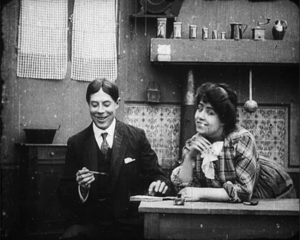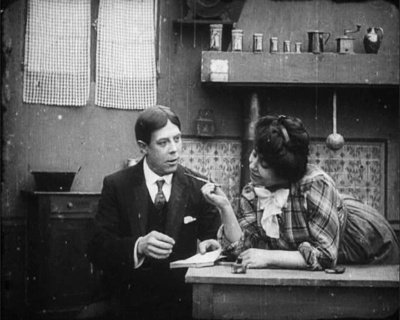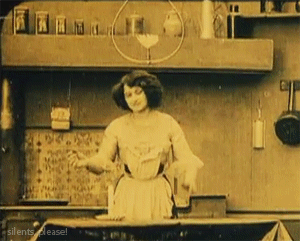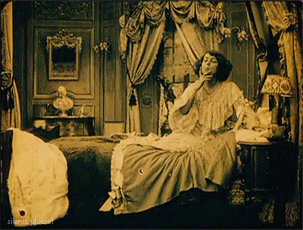Mistinguett must be considered one of France’s great entertainers. Born Jeanne Florentine Bourgeois in 1875, in the early twentieth century she was a huge star of the French music hall, lighting up the stage of such legendary venues as the Moulin Rouge, El Dorado, and the Folies Bergère. At one point, she was the highest paid female entertainer in the world. In 1919, she insured her legs for 500,000 Francs! She likely originated the danse apache, and it was she who popularized the elaborate headdresses now associated with ‘showgirl’ performances. Although not an elite singer, dancer, or beauty in the pure sense, this Queen of the Music Hall was a true performer who won over audiences through the sheer force of her charisma and confidence.

Mistinguett and Max Dearly’s valse chaloupée (danse apache)
Apart from her stage performances, Mistinguett recorded prolifically (her 1916 song “Mon Homme” became a standard), and appeared in many films, initially with SCAGL (Société cinématographique des auteurs et gens de lettres), a company founded in 1908 to produce films d’art and who contracted many famous stage performers of the day. Early on she appeared in L’empreinte ou La main rouge (1908), in which she and Max Dearly performed their apache dance, and she was successfully paired with leading comic Charles Prince in the Rigadin series. Perhaps her most famous role was Éponine in Albert Capellani’s 1913 adaptation of Les Misérables. I’m also intrigued by La Glu | The Siren (1913), which Mariann Lewinsky describes as “a true diva film”; and a pair of films in which she played a detective—called, appropriately, Mistinguett détective.
None of the aforementioned films are readily available to watch, but several short films Mistinguett appeared in are available on DVD: Les timidités de Rigadin, La Doctoresse (both 1910), and L’Épouvante (1911). While it is difficult to generalize about her overall screen career from these titles, let’s take a look and see what kind of film performer Mistinguett was at the turn of the nineteen-hundreds.

… the mice will play.
In Les timidités de Rigadin (English title: A Shy Youth), the master and mistress of the house have headed out for the evening, and the servants decide to have a party in their absence. Meanwhile, Rigadin, who has been sent to call upon the family—and particularly their daughter—arrives. As his letter of introduction tells the audience, “he is a very nice youth and well brought up in every way”, with just one flaw: “he is too shy”. When he mistakes housemaid Mistinguett, dressed up in finery, for the daughter of the house, she decides to have a bit of fun at Rigadin’s expense. After almost knocking him out with an almighty headbang, the rest of the servants look on as she flirts outrageously with the flustered Rigadin.


The famous legs.
She dresses him in a homemade suit of armour made out of kitchen utensils and forces him to sing Wagner’s Lohengrin. By this point, Rigadin is pretty into it—as is Mistinguett, enthusiast conductor.

The film ends, of course, with the family of the house coming home and wondering who the capering madman wearing cheesegraters and a funnel is. Rigadin hands the Flumkins his letter of introduction—through the door in the apparatus strapped to his chest!—but naturally the letter’s characterization of the ‘shy lad’ is not convincing in light of this singing wannabe-knight, and Rigadin is kicked out of the house.
While Les timidités de Rigadin is a pas de deux rather than a one-woman show, Mistinguett’s charisma shines through: she’s confident and is clearly having fun. The film is rather broad in its humour and Mistinguett is playing to that pitch, doing a lot with body language and gesture, as seen in the gifs below. To the better, as well, that the plot gives this woman famed for her flamboyance the chance to dress up!


Partying with Mistinguett looks like a lot of fun.
La doctoresse (The Lady Doctor) of later the same year also partners Mistinguett with Rigadin, but is entirely different in tone. Working life, family, and womanhood: can women have it all? The question is far from settled even today. Mistinguett is the titular lady doctor, a busy career woman whose husband Rigadin feels neglected and/or intimidated and “seeks amusement elsewhere”.


Mistinguett sees a patient; Rigadin’s eye wanders.
Rigadin goes to a music hall/carnival and is hanging out with the performers back stage. He is enthralled with the strongwoman and her barbell, which he tries to lift … and predictably fails, dropping the weight on his foot.


The strongwoman demonstrates.
Gosh, how lucky that his wife is a doctor! She rushes to the rescue and treats him. The day is saved and the husband and wife laugh together, reaching a rapprochement.
Just kidding! She faints on hearing the news, and we see the following intertitle:
The point is driven home by the ending shot of the film, in which she smashes the bust that lives in her office (I presume that it is of a famous doctor), renouncing the medical profession forever.
And the moral of the story is … the husband is always right! If Mistinguett hadn’t driven him away with her unattractively ‘masculine’ ambition, her book-learning and her professional job, he wouldn’t have needed that medical attention in the first place! Raaaaage. I suppose that looked at objectively, La Doctoresse presents a couple who both contribute to the issues in their relationship, but I’m not inclined to be charitable, given that the ending not only blames the wife for the idiotic foibles of the husband, but also demands that she give up doctoring on those grounds. Insulting, to say the least.

Mistinguett. Look at this man. His hair alone should convince you that he sucks.
Much more impressive is L’Épouvante (Terror) of the following year, a short directed by Albert Capellani, one of the filmmaking giants of the time. In this film Mistinguett plays a character much like herself: we see her leaving the theatre after the show, her fans watching as she steps into her motorcar. Back at home, she prepares for bed, removing her jewellery and changing into bedclothes, assisted by her maid.
But the audience knows something that Mistinguett doesn’t: prior to her arrival home, a thief has broken into her house, and upon hearing her entrance, has hidden under her bed. Thus the scene is set for suspense! Mistinguett yawns theatrically and smokes a bedtime cigarette, before the camera pulls back to reveal the burglar hidden below. It’s a shot that is still extremely striking:
When her match falls to the carpet, the thief reaches out to extinguish it, and she becomes aware that he is hiding there. What follows is this set of shots, from high angle to long shot and back—rather astonishing for 1911:
The thief runs out, and a chase begins: he tries to escape along the balconies and roof, while the police arrive in pursuit. There is a chase, and then the thief is hanging from a guttering outside Mistinguett’s window, about to fall. Despite her fear and initial indecision, Mistinguett finds that she cannot let gravity take its course, and helps him back in the window. A role reversal: the victim becomes the saviour. He gives her back the jewels that he took from her, and the film ends.
Capellani’s direction in this film is very impressive. The sets have a great deal of depth, the staging is effective, and the editing is very creative for 1910: tight and tension-heightening. In fact, L’Épouvante could be remade today with relatively few structural changes.

A small detail that I enjoyed: look at the fake kitchen light!
So, what can one conclude from these three Mistinguett films? Three main things, in my opinion. Firstly, that she is assured and charismatic in front of the camera, even when the material is pretty middling. Also, that she was a versatile actress: she could comfortably handle multiple genres—comedy, drama, thriller. And thirdly, that her films—L’Épouvante in particular—played off her image as a famous performer, within the narrative as well as for publicity purposes.
Mistinguett was clearly a capable film actress, in addition to her many other talents. One hopes that more of her films become available in future!
Addendum 13 January: Ann Harding (a.k.a. Christine Leteux, blogger and author of a recent biography of Albert Capellani) has told us about a DVD release of 3 Mistinguett films: Chignon d’or (1915), Fleur de Paris (1916), and Mistinguett détective. The DVD is available here.

– – –
Les timidités de Rigadin [A Shy Youth] and La Doctoresse [The Lady Doctor]. Dir. Georges Monca. France: S.C.A.G.L. (Société cinématographique des auteurs et gens de lettres), 1910. Available on the DVD Centi anni fa: Comic Actresses and Suffragettes 1910-1914, published by the Cineteca di Bologna.
L’Épouvante [Terror]. Dir. Albert Capellani. France: S.C.A.G.L., 1911. Available on the DVD Albert Capellani: Un cinema di grandeur 1905-1911, published by Cineteca di Bologna.
– – –
This post is written for the France on Film blogathon, hosted by Serendipitous Anachronisms. Go and read the other posts here!













This was a lovely contribution to the France on Film Blogathon!
I loved your response to La doctoresse, because I had to re-read that moral a few times, my crazy liberal brain refused to accept it the first go ’round. We can pretend there was a mistranslation on that title card, it should have read, “Love kills ambition”.
L’Épouvante sounds absolutely fantastic and I am once again amazed by the artistry of such an early film, with relatively little tech.
Mistinguett sounds like an a charming actress, I have heard her sing, she is (in my humble opinion) better than Edith Piaf, I will check these films out, and I hope we can look forward to more Mistinguett being re-issued in the future.
Thank you for such a smart and funny contribution!
LikeLike
Thanks for your thoughtful comment, Summer! Yes, the ending of La doctoresse was so enraging. No wonder it took the women of France so long to get voting rights etc, with these kind of messages in pop cultures. Grrr.
Capellani is really great. Recently, the English-language version of Christine Leteux’s biography of him was published, I am looking forward to reading it.
As for Mistinguett herself, I too enjoy her singing. What a lady … She must have been a real force of nature.
Thank you for organising the blogathon!
LikeLiked by 1 person
Thank you too! :D
LikeLike
Pingback: The France on Film Blogathon is here, FINALLY!!!! | Serendipitous Anachronisms
Pingback: The France on Film Blogathon is here, FINALLY!!!! | Serendipitous Anachronisms
Thanks for the introduction to the charismatic Mistinguett. She is fabulous on screen, even in the gifs you posted!
LikeLike
Thanks, I think so too! Even in lo-resolution, she’s totally selling it.
LikeLiked by 1 person
Pingback: Day One #France On Film Recap | Serendipitous Anachronisms
Mistinguett might have been one of France’s greatest entertainers, but she was certainly new to me. I look forward to catching up with some of these films, no matter how ‘politically incorrect ;) I love the idea that she popularised the showgirl look, I’d never given much thought to it.
LikeLike
Thank you, glad you enjoyed! Indeed, it seems that she was the one to popularise the outfits with the giant headdresses, etc. She must have been quite a lady :-)
LikeLike
Agreed, that was an interesting detail to me, too! There’s something very fascinating about discovering where the “firsts” came from.
LikeLiked by 1 person
Once again, you wrote a beautiful article!
One more interesting detail is that she “discovered” Bouboule, an admittedly talented child actress who had worked regularly with Feuillade during 1920-25. What a fantastic period it was!
LikeLike
I have never seen any of Feuillade’s 20s work! I had to look up Bouboule, née Geneviève Juttet. Interesting tidbit, thanks Hans.
LikeLike
I didn’t know this actress, but you made a very interesting portrait of her. :)
LikeLiked by 1 person
I was so excited when I saw your topic. Thank you so much for this post. She is someone I had read about, but never had the pleasure to encounter. Merci!
LikeLiked by 1 person
Merci beaucoup!
LikeLike
Adding to the chorus of thank yous – I’d never heard of Mistinguett before, but am really intrigued to check out some of her work… darn my feminist blood pressure ;-)
LikeLike
Thanks! I really like covering interesting ladies from the silent film period, and she is certainly that. :)
LikeLike